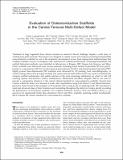Evaluation of Osteoconductive Scaffolds in the Canine Femoral Multi-Defect Model
Author(s)
Luangphakdy, Viviane; Walker, Esteban; Shinohara, Kentaro; Pan, Hui; Hefferan, Theresa; Bauer, Thomas W.; Stockdale, Linda; Saini, Sunil; Dadsetan, Mahrokh; Runge, M. Brett; Vasanji, Amit; Yaszemski, Michael; Muschler, George F.; Griffith, Linda G.; ... Show more Show less
DownloadGriffith_Evaluation of.pdf (1.718Mb)
PUBLISHER_POLICY
Publisher Policy
Article is made available in accordance with the publisher's policy and may be subject to US copyright law. Please refer to the publisher's site for terms of use.
Terms of use
Metadata
Show full item recordAbstract
Treatment of large segmental bone defects remains an unsolved clinical challenge, despite a wide array of existing bone graft materials. This project was designed to rapidly assess and compare promising biodegradable osteoconductive scaffolds for use in the systematic development of new bone regeneration methodologies that combine scaffolds, sources of osteogenic cells, and bioactive scaffold modifications. Promising biomaterials and scaffold fabrication methods were identified in laboratories at Rutgers, MIT, Integra Life Sciences, and Mayo Clinic. Scaffolds were fabricated from various materials, including poly(L-lactide-co-glycolide) (PLGA), poly(L-lactide-co-ɛ-caprolactone) (PLCL), tyrosine-derived polycarbonate (TyrPC), and poly(propylene fumarate) (PPF). Highly porous three-dimensional (3D) scaffolds were fabricated by 3D printing, laser stereolithography, or solvent casting followed by porogen leaching. The canine femoral multi-defect model was used to systematically compare scaffold performance and enable selection of the most promising substrate(s) on which to add cell sourcing options and bioactive surface modifications. Mineralized cancellous allograft (MCA) was used to provide a comparative reference to the current clinical standard for osteoconductive scaffolds. Percent bone volume within the defect was assessed 4 weeks after implantation using both MicroCT and limited histomorphometry. Bone formed at the periphery of all scaffolds with varying levels of radial ingrowth. MCA produced a rapid and advanced stage of bone formation and remodeling throughout the defect in 4 weeks, greatly exceeding the performance of all polymer scaffolds. Two scaffold constructs, TyrPC[subscript PL]/TCP and PPF4[subscript SLA]/HA[subscript PLGA Dip], proved to be significantly better than alternative PLGA and PLCL scaffolds, justifying further development. MCA remains the current standard for osteoconductive scaffolds.
Date issued
2013-01Department
Massachusetts Institute of Technology. Department of Biological EngineeringJournal
Tissue Engineering Part A
Publisher
Mary Ann Liebert, Inc.
Citation
Luangphakdy, Viviane, Esteban Walker, Kentaro Shinohara, Hui Pan, Theresa Hefferan, Thomas W. Bauer, Linda Stockdale, et al. “Evaluation of Osteoconductive Scaffolds in the Canine Femoral Multi-Defect Model.” Tissue Engineering Part A 19, no. 5–6 (March 2013): 634–648. © 2013 Mary Ann Liebert, Inc.
Version: Final published version
ISSN
1937-3341
1937-335X